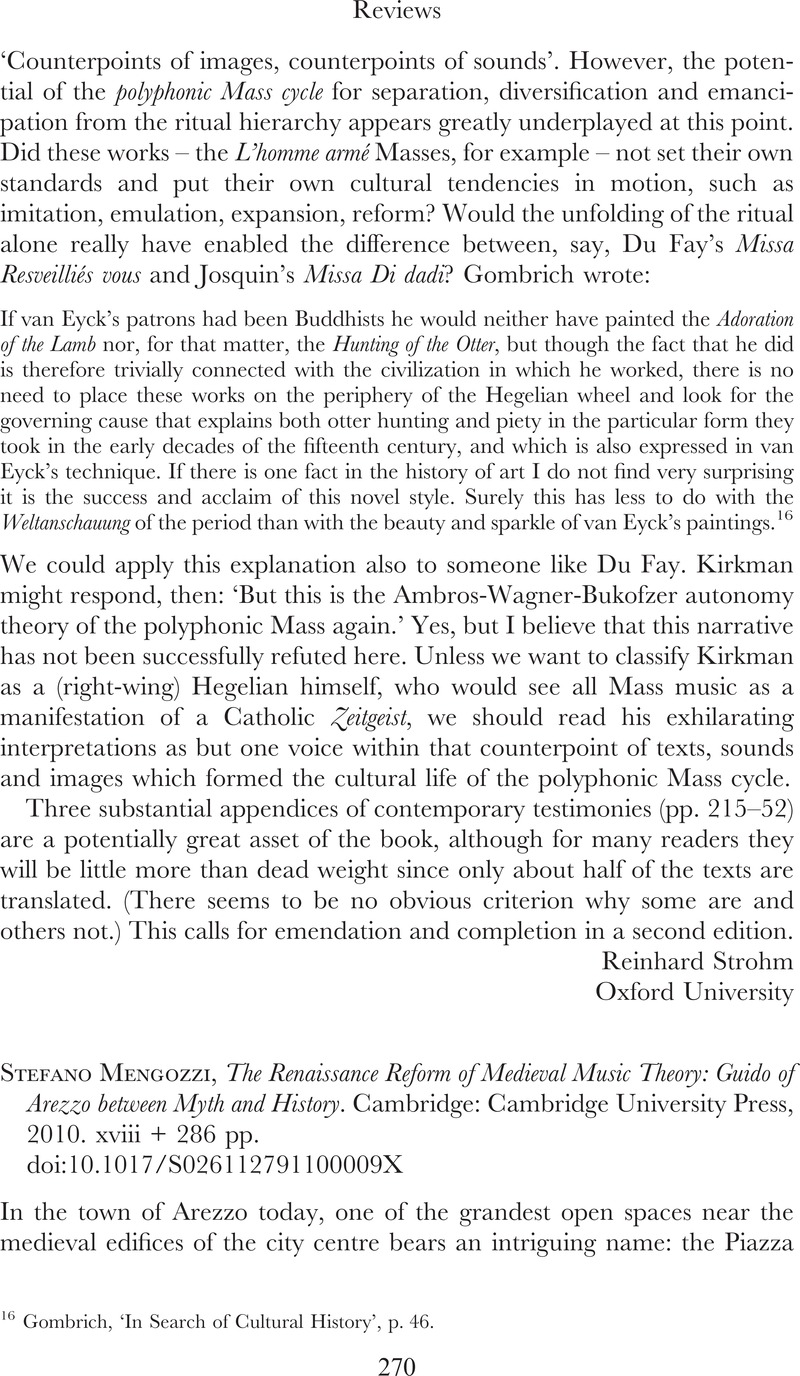No CrossRef data available.
Article contents
Stefano Mengozzi, The Renaissance Reform of Medieval Music Theory: Guido of Arezzo between Myth and History. Cambridge: Cambridge University Press, 2010. xviii + 286 pp.
Published online by Cambridge University Press: 08 September 2011
Abstract

- Type
- Reviews
- Information
- Copyright
- Copyright © Cambridge University Press 2011
References
1 It is interesting to note, in this regard, how much more prominently the words ‘Medieval Music Theory’ are displayed on the book's cover than the crucial first part of the title, ‘The Renaissance Reform of …’.
2 <http://www.chmtl.indiana.edu/tml/>. Excessive reliance on the TML has its drawbacks as well: the book's frontispiece, a gamut table from British Library MS Harley 978, has clearly been reproduced from an image file in the TML (13th/ANOINT_01GF.gif). The reproduction owes its poor quality (worse than that of a fax transmission!) to the TML's need to keep file sizes severely restricted when the project went online in the 1990s.
3 Compositions apparently intended to bear solmisation titles can be considered categorically different than those which were given such titles by copyists, as a way of indicating their opening motifs when the model was unknown.
4 Explored more exhaustively in Wegman, Rob C., The Crisis of Music in Early Modern Europe, 1470–1530 (New York, 2005)Google Scholar .
5 As far as Mengozzi's survey of previous work shows, it is mainly Crocker who emphasised the centrality of the sixth, and even then perhaps not with exactly the structural nuance Mengozzi wants to read (the Guidonian hexachord ‘remained the central concept for both chant and polyphony up through the sixteenth century’, quoted on both p. 20 and p. 42).
6 Anon., [De discantu et contranota], ed. Peter Lefferts, TML: <http://www.chmtl.indiana.edu/tml/14th/ANODDC_MLBL2145.html>; (accessed 1 Feb. 2011).
7 De musica libellus, ed. Reaney, Gilbert (Corpus Scriptorum de Musica, 36; n.p., 1996), p. 75Google Scholar .
8 On the earlier end, an English diagram from c. 1200 showing a fully developed gamut system with three proprietates (natural, hard, and soft hexachords) is extraordinarily early; see the reproduction on p. 78.
9 E.g., Bartolomeo Ramos de Pareja, Musica practica (Bologna, 1482), Pars 1, Tract. 2, Cap. 7; ed. Johannes Wolf (Leipzig, 1901), pp. 43–4.
10 See the reproduction on p. 156, Fig. 6.3. Interestingly, the letter A receives the syllable la but in the higher two octaves is also accompanied by a superscript mi (‘Ami’) to maintain a mi–fa relation for the semitone between A and B♭. Gallicus's apparently straightforward gamut revision thus maintains the principle of mutation which he had criticised as overly complex.
11 Tinctoris, Johannes, Liber de natura et proprietate tonorum, cap. 8; Johannis Tinctoris Opera theoretica, ed. Seay, Albert (Corpus Scriptorum de Musica, 22; Rome, 1975–8), i, p. 74Google Scholar .


